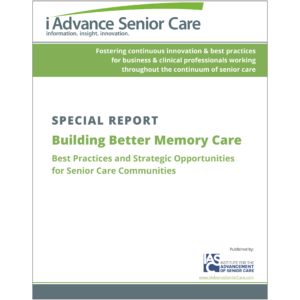How to Design a Dining Plan That Works for Your Senior Care Community
Dining opportunities play a major role in a senior care community’s success. The quality of the dining offerings can help attract potential residents, contribute to resident satisfaction, and contribute to resident wellness and health.
As such, it’s essential to focus on designing a dining plan that truly meets an individual senior care community’s needs. From menu design to the construction and design of the physical dining spaces, it’s important to not only put time and effort into the dining options, but to also create a solution that’s tailored to the community.
Why It’s Important to Customize Dining to Your Senior Care Community

Don Bundren, food solution design and culinary director at Sodexo Seniors
Don Bundren, food solution design and culinary director at Sodexo Seniors, explains that dining offerings are unique to each senior care community, and they should be designed to reflect the community’s unique needs. “We specialize in partnerships and contract services,” he says, “and I think it’s important as a partner to really understand the client’s strategic, long-term plan.”
When working with a client, Bundren gathers key information, like whether the client has outside investors, is a private pay facility or is open to the public, and whether there’s anticipated growth in the client’s future.
“The pandemic changed a lot,” he says. “How do we pivot? Coming out from the other side of the pandemic, a lot of communities are looking at what their future is.” Given the census drop that many communities experienced, renovating their dining facilities may be part of their plan to rebuild their census.
Essential Considerations When Designing Dining Facilities
When designing a dining facility, whether it incorporates new construction or the renovation of existing dining facilities, Bundren highlights the importance of identifying the senior care community’s vision and long-term goals.
It’s also essential to incorporate all of the designers and contractors involved in the process, facilitating conversations and designing a functional space. “It’s important to bring all of these partners together and have those clear conversations,” says Bundren.
Bundren notes that Sodexo Seniors uses localized consumer insights to build dining and hospitality recommendations for clients. With the data, senior care communities can better understand the audience they are trying to attract, including their likes and dislikes. They can use that data to better inform their dining plans, ensuring that they appeal to the client’s base.
Challenges When Creating Dining Plans
From an operational perspective, Bundren explains that finding a partner who has the right vision and understanding for a senior care community’s project can be a challenge. “You can start going down an expensive path, and it can really stretch things out if you, the designer, and the food service partner aren’t connected,” he says.
He also explains that it’s important for the senior care community to openly communicate plans to the current residents and staff. “If you go down a journey where the current residents and community aren’t involved, there won’t be buy-in,” says Bundren. “I think they won’t understand the journey unless you really communicate the reasons why you’re making these changes.”
To successfully navigate that conversation, he encourages a senior care community to place completed renderings in a lobby or open space where residents can view them. “Residents want to know what’s coming and what’s happening,” he says. “Be open and honest about the ultimate goal for the community.”
He explains that multiple conversations need to take place even during the early stages of the planning process. The dialogue should begin with smaller conversations with the board of directors. Once the project reaches milestone decisions, it’s important to start releasing information. “If you release information too soon, everyone has input,” he says. Instead, he suggests that a community engage residents in making certain decisions, like choosing fabric for chairs or testing samples of a chair to decide which model is best.
Budget can also be a challenge, but there are multiple days to plan dining renovations while helping to control costs. Bundren recommends approaching renovations in smaller pieces. “You know your four walls, and you need to understand how you can expand or work within those walls,” he says. “That sets a financial picture of what you can do.”
Leveraging convertible spaces can also give a community maximum value for its investment. “Convertible spaces are the way to go for savings,” Bundren says. “How do you create dining spaces that bring together the community with front-of-house staff and residents? Nothing creates more synergy and makes the community come alive than when you have something active in common areas, like a coffee bar or a convertible space that transitions into a happy hour space in the afternoon.”
Current Dining Trends in Senior Care
Bundren notes that as residents have a more active lifestyle, the need for multiple sit and serve environments has decreased. Given the staffing challenges, it’s important to create spaces that engage staff, especially when they have to work overnight. Focus on the options available to make staff feel comfortable, and make sure that staff can get food throughout all of the shifts. He encourages senior care communities to renovate dining spaces approximately every 10 years to avoid falling behind.
While technology is increasingly present in the dining space, Bundren notes that if residents aren’t ready for the technology, they won’t use it. It’s important to have resident buy-in when installing technology, or it could be a waste of a significant amount of money.
When it comes to dining menus, Bundren recommends updating menus seasonally, and at least twice a year. “Refresh the menu and any activities that go along with it,” he says. “You always want to keep the core menu alive and exciting. That gets participation and gets residents engaged.”
While renovating dining spaces and redesigning menus is an important investment in the environment and quality of care a senior care community offers, it’s also an investment in attracting future residents. A fresh, exciting menu also offers the opportunity to engage with potential residents, says Bundren. “The more you can get them coming into the community and dining with you, the greater the chance they are going to want to move in.”

Paige Cerulli is a contributing writer to i Advance Senior Care.
Related Articles
Topics: Activities , Design , Featured Articles , Information Technology , Nutrition , Operations , Resident Care , Staffing











